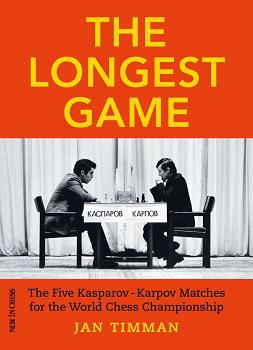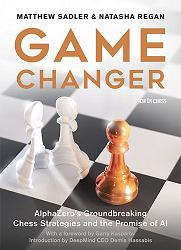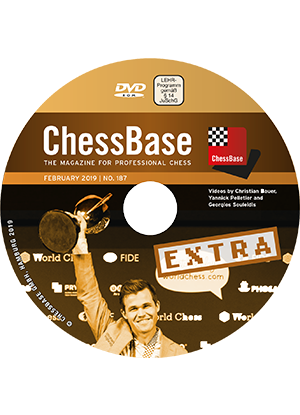Latest book
reviews of 1 March 2019
Wilhelminalaan 33John Elburg
7261 BP RUURLO
The Netherlands.
Chess Books

The Longest Game: The Five Kasparov — Karpov Matches for the World Chess Championship
by Jan Timman
2019
New in Chess
http://www.newinchess.com/
365 pages
Price € 29,95
ISBN: 978-90-5691-811-8
The former World Champion candidate Grandmaster Jan Timman from Arnhem ,covers in his latest New in Chess Book,The five famous Kasparov – Karpov matches, of Moscow 1984/85,Moscow 1985,London/Leningrad 1986,Sevilla 1987 and New York/Lyon 1990.
As we all know all of these games are also covered in Kasparovs heavy weights on Modern Chess part Two, Three and Four.
Jan Timman has brought these games back to daylight with 50 annotated games and 17 game fragments, all written in a very instructive way of understanding and even more important checked with the help of latest chess machines.
As Timman explains; my own findings are also doomed to require corrections after an x amount of time.
The advantage of one volume book makes this work the perfect companion of the match and the author does not get lost in dreadful long analyses as Kasparov so preferred in his above mentioned heavy weights.
Conclusion: I enjoyed this book for the instructive analysis, behind the scene impressions and all the twists and turns of the match!

Game Changer: AlphaZero's Groundbreaking Chess Strategies and the Promise of AI
by Matthew Sadler& Natasha Regan
2019
New in Chess
http://www.newinchess.com/
415 pages
Price € 22,50
ISBN: 978-90-5691-818-7
The well known Grandmaster Matthith Sadler and Women’s International Master Natasha Regan describe in this 415 page heavy weight the fascinating story of the artificial intelligence system AlphaZero.
AlphaZero is quite different to other handcrafted chess engines because AlphaZero learns its strategy from doing rather than drawing on pre-specified human expert knowledge.
Grandmasters for example train many hours and days researching the latest developments, and often adopt a strict diet and exercise regime, AlphaZero simple does it all against it self,and plays around 1000 games per second.
All material of this book is packed in five readable chapters: AlphaZero’s history, Inside the box,Themes in Alpha Zero’s play, AlphaZero’s opening choices and conclusion.
There is an introduction by Demis Hassabis and a foreword by no less than Garry Kasparov.
Where I would like to use the following words from our Deep Blue expert: AlphaZero’s strength is impressive, but its method is far more important.
AlphaZero’s isn’t just applying human knowledge and ploughing through billions of positions to generate moves, it’s creating its own knowledge first. And based on its results and my observations, the knowledge it generates for itself is unique and superior.
The play of wonderboy Magnus Carlsen comes from close to the play of AlphaZero as we can see in the following game: Carlsen,Magnus (2690) - Ivanchuk,Vassily (2750) [D88]
Morelia/Linares 24th Morelia/Linares (11), 06.03.2007
1.d4 Nf6 2.c4 g6 3.Nc3 d5 4.cxd5 Nxd5 5.e4 Nxc3 6.bxc3 Bg7 7.Bc4 c5 8.Ne2 Nc6 9.Be3 0-0 10.0-0 Na5 11.Bd3 b6 12.Rc1 cxd4 13.cxd4 e6 14.Qd2 Bb7 15.h4 Qe7 16.h5 Rfc8 17.e5 Rxc1 18.Rxc1 Rc8 19.Rxc8+ Bxc8 20.Bg5 Qc7 21.Bf6 Nc6 22.Qg5 h6 23.Qc1 g5 24.Bb5 Bd7 25.d5 exd5 26.Nd4 Bxf6 27.exf6 Qd6 28.Bxc6 Qxf6 29.Bxd7 Qxd4 30.g3 Qc5 31.Qxc5 bxc5 32.Bc6 d4 33.Bb5 Kf8 34.f4 gxf4 35.gxf4 1-0,both authors write after 15.h4:The young Carlsen plays a move that AlphaZero like too! White exerts pressure on the black kingside with the h-pawn.
Interesting are Magnus words after this game: After this game had finished I had a strange feeling, since I could not really understand what that had just happened: Without making any particularily spectacular moves I had just beaten one of best players in the world. It seems to me that Ivanchuk must have had an extremely bad day (as it seemed to me, for most of this tournament he played really well).
Conclusion: One of the most interesting reads of this moment!

Tal, Petrosian, Spassky and Korchnoi
A Chess Multibiography with 207 Games by Andrew Soltis
2019
McFarland & Company,Inc.,Publishers Box 611
Jefferson,North Carolina 28640.
http://www.mcfarlandpub.com
368 pages
Price $65.00
ISBN: 978-1-4766-7146-8
Bibliographic Info: photos, 207 games, appendices, notes, bibliography, index
It is great pleasure to announce this wonderful made chess multi biography with 207 games from Andrew Soltis on the legendary players Tal,Petrosian,Spassky and Korchnoi.
The strong point from this book is the unbelievable amount of less known background information that Andrew Soltis did manage to dig up on these four chess players.
It is hard to believe that a top 21st century grandmaster who at age 11,had to use his sled to drag the body of his grandmother more than a mile over icy roads so he could bury here,but Korchnoi did.
Later Korchnoi became the seconds highest rated player in the world,behind Bobby Fischer.He would remain there for three years. It took consistently good,if not great,results to hold his place and Korchnoi did it with first prices at the international tournaments of Palma de Mallorca 1968,Sarajevo 1969,Havana 1969 and Luhacovice 1969.
Mikhail Tal was married to Salli Landau {1959–1970} but in 1964 Tal had a love story with the movie star the eight year older Larisa Sobolevskaya.She was a first class category player and KGB agent.In her spy werk code named “Lora”she had seduced a French ambassador.
Tal used his price money from Havana 1963 to buy a fur coat for Larisa Sobolevskaya.
The 207 games are all well analysed and a fine example of Korchnoi’s play of that time is:
Kortschnoj,Viktor Lvovich - Geller,Efim P [C58]
URS-ch20 Final Moscow (7), 08.12.1952
1.e4 e5 2.Nf3 Nc6 3.Bc4 Nf6 4.Ng5 d5 5.exd5 Na5 6.d3 h6 7.Nf3 e4 8.Qe2 Nxc4 9.dxc4 Bc5 10.h3 0-0 11.Nh2 Re8 12.Be3 Bxe3 13.fxe3 Qd6 14.Nc3 a6 15.0-0-0 Bd7 16.Rd4 b5 17.Nf1 b4 18.Nd1 c6 19.dxc6 Qxc6 20.Nd2 Re5 21.Rf1 Be6 22.g4 Qa4 23.Qh2 Rg5 24.Rxf6 gxf6 25.Nxe4 Rg6 26.Qf4 Kg7 27.Ng3 Qxa2 28.Nh5+ Kh8 29.Qc7 Kh7 30.Nf4 Rg7 31.Qb7 Re8 32.Qxb4 f5 33.Nh5 Rg6 34.c5 fxg4 35.hxg4 a5 36.Qb7 Rc8 37.c6 a4 38.Qa6 a3 39.bxa3 Bb3 40.Qd3 Rcxc6 41.Nc3 Qxa3+ 42.Kd2 ½-½,Soltis instructively explains after11.Nh2:This looks ugly but it is difficult to get at white’s weaknesses. For example,11…e3 12.Bxe3 Bxe3 13.fxe3 Ne4 14.Nf1 Qh4+ 15.g3 Qf6 16.c3 Bf5 is thematic.
But it is also the kind of position that allows Korchnoi to defend and defend,until he could counter sacrifice.
Conclusion: This is certainly Soltis on it’s best!
Chess DVD's
UltraCorr 2019
www.chessmail.com
E-mail hardingt@tcd.ie
The basic price for a downloaded copy is 55 Euro
It is great pleasure for me to release the news of Tim Hardings latest UltraCorr 2019 download which gone to nearly two million games,for the good order it holds exactly counted 1957486 games and that is a small 165695 more games than his previous 2017 release.
For the interested correspondence chess player the ChessBase 2018 edition has only 1431813 entries.
An than I did not even mention Harding’s uncountable references to the games!
As we all know Tim Harding is a highly regarded chess historian who has written in the past outstanding chess books and Harding’s knowledge comes back in the research of historic games, references to the games and more.
But I am also impressed by Hugh amount of games that Tim Harding did manage to download from the LSS site https://lss.chess-server.net/ because that had to be done file by file, it is a great pity that Ortwin Paetzold has lost completely interest for a reasonable function of his website.
For example see the following notes from the forgotten player Mathäus Seibold who played several correspondence games against the legendary Paul Keres.
Seibold,Matthaus - Keres,Paul [C12]
Deutsche Schz. intl. CC tourney-3 3233 corr, 1932
[Keres]
In the Nunn edition of "Paul Keres, The Road to the Top" (game 2) White's name is incorrectly given as "Siebold". This was earlier in vol. 1 of the 3-vol Golombek edition in the 1960s, and (among non-CC players anyway) is probably the best known CC game of Keres. 1.e4 e6 2.d4 d5 3.Nc3 Nf6 4.Bg5 Bb4 Keres commented in later years; "In the French Defence my favourite system was the MacCutcheon variation and I tried to use it at every opportunity. Here too the wish to make the game as violent as possible from the very first moves was dominant." 5.e5 h6 6.Bd2 Bxc3 7.Bxc3 Keres notes that between 1932-36 the two players had several games with the usual 7 bxc3 but this time Seibold wanted a change. 7...Ne4 8.Qg4 Kf8 "At that time, in such positions I always preferred the ¢ move to the alternative 8...g6". 9.Bd3 Nxc3 10.bxc3 c5 11.h4 "At the time the game was played I deemed the text-move not good and recommended as better for White [11.Qd1 Qa5 12.Qd2 Nc6 13.Nf3 so as to keep the pawn position in the centre compact. This would, however, lead to a quieter level position, whereas after the text-move the game pursues an interesting and exciting course."] 11...Qa5! 12.Kd2 Nc6 [12...cxd4 13.Qxd4 Nc6 14.Qf4 d4 15.Ne2 was feared during the game but Black can play (¹15.Nf3! Qxc3+ 16.Ke2©) 15...dxc3+ 16.Nxc3 Qxe5] 13.Nf3 [13.dxc5 Nxe5 (13...d4 14.Ne2 (or 14.Nf3!? Qxc3+ 15.Ke2©) 14...dxc3+ 15.Nxc3 Qxc5 thought good by the young Keres but the mature Keres wrote "it now seems to me that White's position is not bad after" 16.f4) 14.Qb4 was thought bad for Black by the mature Keres, but Nunn gives 14...Qc7 White's centre has disappeared and the continuation 15.c6+ Kg8 16.cxb7 Bxb7 17.Rb1 Rb8 is clearly bad for White (JDMN)] 13...cxd4 14.Nxd4 Nxe5µ TH: But now White starts to play better: 15.Qg3! [RR15.Qf4 f6 TH] 15...Nxd3 [15...f6 16.Rae1! threatening an exchange sacrifice on e5 (16.f4 Nxd3 17.cxd3 Bd7) .16...Nxd3? 17.Nxe6+ Bxe6 18.Qd6+] 16.Qd6+! White obtains a lasting initiative in return for the pawn sacrifice. 16...Ke8 White wishes to ensure that his ¥ can be developed via d7, but in doing so his ¢ remains in a most precarious position. [16...Kg8 17.cxd3 Kh7 deserved consideration] 17.cxd3 Bd7 18.Rhe1 Rc8 19.Rac1! White was, of course, threatening 19 ¤f5. The text-move gains an important tempo for the defence. 19...Qc5! [Obviously Black cannaot afford the time to take the a-pawn. RR19...Qxa2+? 20.Rc2 Qa5 21.Nf5!;
19...Qc7 is also bad on account of 20.Nf5! Now White cannot make this move as his f2-pawn would be en prise.] 20.Qe5 Kf8 21.g4
2r2k1r/pp1b1pp1/4p2p/2qpQ3/3N2PP/2PP4/P2K1P2/2R1R3 b - g3 0 0
The first storm is over and the situation can now be assessed. White undoubtedly has good atacking chances in return for the pawn sacrificed, but the position has concealed in it a number of interesting and complicated possibilities, since the white king is not particularly well placed. [21.Re3!? also merits consideration.. .21...b5 22.Nb3 followed by d4] It should, however, be observed that at time in our correspondence games we paid less regard to a careful defence than to direct attacks on the king. Once this is taken into consideration the following moves are easy to understand. 21...b5! 22.f4 b4 23.cxb4 [Naturally 23.c4 was more prudent and would have led to a roughly balanced ending after 23...dxc4 24.Rxc4 Qxe5 25.Rxc8+ Bxc8 26.Rxe5 But our intentions were obviously far away from the endgame.] 23...Qxb4+ 24.Ke3 [24.Ke2 Qb2+ 25.Kf3 Kg8 (25...Qxc1 26.Nxe6+) ] 24...f6! It is easy to see that White must not capture either on c8 or e6. 25.Qh5 e5? [Nowadays I would have prepared this thrust with 25...Re8 but at that time I was especially entranced by the forced continuation of the text-move with all its combinative possibilities. 26.Rf1 Kg8] 26.fxe5 Re8 27.Rf1! Qb6! So as to be able to renew the threat of ...¢g8, Black must protect the f6-point once more. [27...Kg8 28.Rxf6! leads to a mating attack.] 28.Rb1 Qc7 29.Nf3 Qc5+! 30.d4 [30.Kd2 Kg8] 30...Qc2 threatens ...g6 but White knows how to present his opponent with new and difficult problems. 31.Ng5! g6 [31...hxg5 32.Qxh8+ Kf7 33.Rxf6+! would afford White an attack good enough for at least a draw] 32.Rxf6+ Kg7 33.Rb7! [33.Rf7+ Kg8 and White loses his queen] 33...gxh5 Diagram
4r2r/pR1b2k1/5R1p/3pP1Np/3P2PP/4K3/P1q5/8 w - - 0 0
[33...Re7 34.Ne6+ would ensure White at least a draw.] 34.Rxd7+? [34.Rf7+! Kg8 35.Rfxd7! threatening mate in two. During the game, I had prepared the following variation: 35...Qg6 36.gxh5 Qf5 a) 36...Qxh5 37.Rg7+ Kf8 38.Nh7+ Rxh7 39.Rxh7 etc.; b) The move 36...Qf6 was a possibility only noticed subsequently by Keres 37.Rf7 (37.Nh7 Rxh7 38.Rxh7 Qf5-+) 37...Rxe5+ 38.Kd2! (38.dxe5 Qxe5+ 39.Kd3 hxg5 40.Rfe7 Qf5+ followed by ...£f8 and a clearly won position for Black) 38...Qd8 39.dxe5 hxg5 Black retains some winning prospects.; 37.Rg7+ Kf8 38.Rgf7+ Qxf7 39.Nxf7 Rh7 40.Nd6 though all the same a win for Black is not certain. However, the mature Keres added that after 40...Rxb7 41.Nxb7 Ke7 Black retains excellent winning chances.] 34...Kg8 35.Rff7 Qc3+! 36.Ke2 Rxe5+! With the white rooks placed on b7 and d7 this sacrifice would be useless since a mate with the rook on d8 would be subsequently threatened. 37.dxe5 Qxe5+ 38.Kd3 [After 38.Kf1 hxg5 39.Rf5 Black wins simply by 39...Qb8] 38...hxg5 39.Rf5 [39.Rfe7 Qg3+ 40.Ke2 White must not allow a check on the f-file because of ...£f8, and if(40.Re3 Black wins by 40...Qb8 41.Ree7 Qf8 etc.) ] 39...Qe4+ [39...Qe4+ 0-1. I demonstrated the following continuation to my opponent: 40.Kc3 Qc4+ 41.Kd2 Qb4+ 42.Ke3 or 42 ¢c1 42...hxg4 43.Rxg5+ Kf8 44.Rd8+ Ke7 45.Rxh8 Qc3+ followed by ..£xh8.] 0-1.
ChessBase has this game too in there correspondence database but the game covers no text and the game references are very poor.
UltraCorr-2019 also includes latest updates as ICCF, FICGS, LSS and IECC games to December 2018, and BdF to September 2018.Tim Harding also included many games by the late CC-GM Keith B. Richardson which have seen no other database before.
For the interested reader please see: http://chessmail.com/UCX-files/UC2019-Notes.htm
Conclusion:For me the ever best made correspondence chess data file!

ChessBase Magazine extra issue 187
February 2018
Videos by Christian Bauer, Yannick Pelletier and Georgios Souleidis
ChessBase
http://www.chessbase.com
E-Mail info@chessbase.com
ISSN 1432-8992
Euro 12.99
System requirements:
Minimum: Pentium III 1 GHz, 1 GB RAM, Windows Vista, XP (Service Pack 3), DirectX9 graphic card with 256 MB RAM, DVD-ROM drive, Windows Media Player 9, ChessBase 12/Fritz 13 or included Reader and internet connection for program activation. Recommended: PC Intel Core i7, 2.8 GHz, 4 GB RAM, Windows 8.1 or Windows 10, DirectX10 graphic card (or compatible) with 512 MB RAM or better, 100% DirectX10 compatible sound card, Windows Media Player 11, DVD-ROM drive and internet connection for program activation.
It looks that it is still Christmas time at ChessBase,because this Magazine is totally over filled not only with three super made media files from Georgios Souleidis on the legendary Tal who made at the age of 16 his first queen sacrifice and Chistian Bauer who has a nice openings suprice for us in the Caro-Kann and at last Yannick Pelletier who digs in a impressive way into the so popular London System.
The game file,called extra gamefile is this time good for a overload of 53902 entries and all played between 8-1-2017!! and 29-12-2018!
And as gift comes an extra lucky bag with 29 heavy annotated games where none of these games have seen annotations by ChessBase before!
A fine example is: Caruana,Fabiano (2832) - Carlsen,Magnus (2835) [B33]
World-ch Carlsen-Caruana Tiebreak London (2), 28.11.2018
[Heine Nielsen,Peter]
Finally after 12 draws in the ordinary games, Magnus managed to take the lead in the first playoff-game and break the tie! With 3 more games to go, this was not a must-win situation for Fabiano, but anyway his strategy in the latter part of the match had been to push hard with the white pieces and he stays loyal to the concept: 1.e4 c5 2.Nf3 Nc6 This position we had in all games with Magnus as Black in the match, and would we count colors reversed, even 3 times as White, making it 10 out 14 games starting like this! 3.d4 cxd4 4.Nxd4 Nf6 5.Nc3 e5 6.Ndb5 d6 7.Nd5!? This became the opening tabiya of the match, creating an interesting theoretical discussion in a position very rarely touched at top level. Kramnik did play it succesfully at the recent Olympiad, but still it is very virgin territory meaning both playerd had and used opportunities to discover and play completely new concepts. 7...Nxd5 8.exd5 Ne7 Game 8 and 10 saw the more common 8...Nb8 but in the crucial game 12 Carlsen switched succesfully to 8... Ne7. [Game 8 and 10 saw the more common 8...Nb8 but in the crucial game 12 Carlsen switched succesfully to 8... Ne7.] 9.c4 Ng6 10.Qa4 Bd7 11.Qb4 Qb8!? In game 12 Carlsen played 11...Bf5 but instead of awaiting Caruana's improvement, he deviates first. 12.h4 The ciritical move, and also the best according to the computer, but as the game shows while White might be better, if things starts going Black's way, then this also really weakens the white position. 12...h5 13.Be3 a6 14.Nc3 a5?! Gaining some space, but forcing the white queen to d1 where it attcks the weakness at h5. 15.Qb3 a4 16.Qd1 Be7 17.g3 Qc8!? 18.Be2 Bg4 Although White was not neccesarily threatening yet to take on h4 due to c4 would fall, then Rc1 is next for White, so in reality Magnus just takes care of problems before they become imminent. 19.Rc1 [19.f3 would be logical, not allowing Black, who has somewhat less space to make an exchange, but after 19...Bd7 potentially ...f5-f4 could become a strategic threat.] 19...Bxe2 20.Qxe2 Qf5 The computer gives White quite an edge, in the region of +0.60. Objectively White is better, but how to assess it from a practical point of view? Caruana has to play a very unfamiliar structure, and while if he does things right he will have some positional edge, if things go wrong Black will get counterplay against the white king. 21.c5?! A very logical move, yet a bad one. [21.0-0 0-0 22.Bg5!? with the idea of
22...Bxg5 23.Qxh5! would be one way of keeping a white edge.] 21...0-0! [21...dxc5 22.Bxc5 Bxc5 23.Qb5+ Qd7 24.Qxc5 would simplify the position while keeping a white initiative, but obviously Magnus does not want to play into White's hands that easily.
] 22.c6 bxc6 23.dxc6 In principle White could be positionally winning, a strong passed pawn and an outpost for his knight on d5. But Black obviously is moving every second time, and White will nowhere near be in time to set up his intended dream position. 23...Rfc8 24.Qc4 [Maybe Caruana planned 24.Nd5 but only now realised that 24...Qe4! turns the tables immediately?] 24...Bd8 25.Nd5 e4 The computers calls this equal, which is correct in a theoretical sense. 26 Bd4! stopping ...Ne5 but both 26...Ba5+ or 26...Ra5!? is certainly promising from black from a practical aspect. However the game would go on, while now its shockingly over in just 3 moves(!) 26.c7 [26.Bd4! stopping ...Ne5, but both 26...Ba5+ (or 26...Ra5!?) is certainly promising for Black from a practical aspect. However, the game would go on, while now it's shockingly over in just 3 moves (!).
] 26...Bxc7! 27.Nxc7 Ne5 Nominally White is a piece up, but apart form threatening the queen, Black's knight is about to enter the critical squares at d3 or f3, winning material or even more relevantly aiming for a mating attack. White is plainly lost. 28.Nd5!? A last desperate attempt. [28.Qd5 Rab8! was Magnus' plan, with the threat of 29...Rxc7 followed by a check by the knight and then picking up the unprotected queen at d5.] 28...Kh7! Obviously not allowing 28...Rxc4?? 29.Ne7+ Black brings his king to safety whereafter his threats becomes intolerable. If 29..Qe2 then 29...Nd3+ ends up with Black considerably up in material, and as 29. Ne7 Qf3! also ends in immediate disaster, Caruana resigned.[28...Rxc4?? 29.Ne7+;
28...Kh7! 29.Qe2 (29.Ne7 Qf3!) 29...Nd3+-+] 0-1.
Conclusion : Certainley one of the best ever made extra magazines !

Get all annotated games from the World Championship 2018 free with annotations by Anand, Adams, So, Shankland, Duda, Gelfand amongst other. It's that simple: if you have a chessbase shop account already click on this link and login.